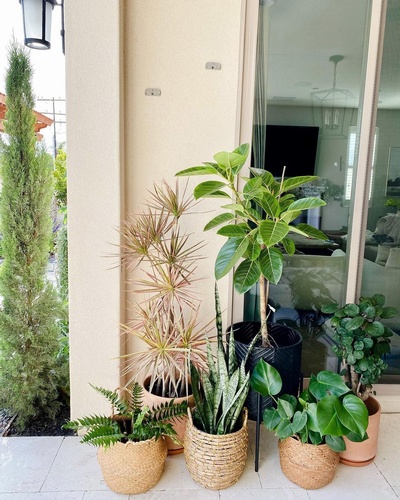Party's Over: Bringing Your Plants Back Indoors From the Summer

Image by @rootsandshootsplantcare
Well, Autumn is officially here. And the cooler temperatures mean that we need to bring any houseplants back indoors that were lucky enough to live outside for the summer. Let's talk about how to do this.
What's the proper temperature to bring plants indoors? A few chilly nights should be fine for most houseplants. But you will want to bring them in before nighttime temperatures dip below 10°C.
Step 1: Assess the Situation
Do I have enough space?
Maybe you leaned hard into plant parenthood over the pandemic. Between a bunch of new plants, sourdough starter, and half-finished knitting projects, you may find that you don't have the same amount of space indoors as you did last Autumn. Add to this the fact that your plants may have grown considerably over the summer while outdoors, and you will quickly see that space is at a premium.
You may decide to let go of some plants that are on the struggle bus or simply no longer spark joy. Consider selling, trading, or giving them away to friends or family.
Do I have enough light?
There is no shortage of natural light outside for our plants to thrive in. Unfortunately, this isn't always the case in our homes. Plants that want full sun outdoors will need to be in a south or west-facing window over the cooler months. East or north-facing windows are great for plants that need bright-indirect to medium light. Plants that receive insufficient light will become leggy and etoliated. You may even notice that they lack their rich colours.
Consider grow lights:
This will allow for plants to be away from prime window real-estate. Grow lights come in a variety of styles and prices so there is one for every budget and need. Remember that because they are supplementing natural light, they need to be on for at least 8 hours every day, so putting them on a timer will take care of this for you. Check out our previous blog post for a deeper dive into using grow lights.
Do I have enough humidity?
Consider a humidifier:
Typically our homes are dry from our heating systems. It can be a real struggle to maintain a fraction of the humidity that we get from being close to Lake Ontario in summer. Dry air will cause crispy leaves, stunted or deformed growth, and can create the perfect habitat for spider mites. Misting is good, but it tends to provide only a temporary solution. Opt for a humidifier to ensure consistent humidity levels.
Do I change how I water?
Remember that as the growing season ends, plants need less water than they did during their period of active growth. Add to this that outdoor conditions such as wind, temperature, and direct sunlight cause water to evaporate from soil quickly. So a plant that you may have watered every 2 or 3 days outdoors, may only need to be watered indoors every 7 to 10 days. To ensure that you are not over-watering your plant, water by touch by placing your finger into the soil. Or get a moisture meter to really determine if it needs a drink or not. This is also true of fertilizing your plant. It is best done only during periods of active growth, so don't worry about it too much during colder months. If you do wish to fertilize then, choose a gentle option like worm castings.
The transition from outdoors to indoors can shock some plants. You may notice some leaves dropping, but with time, and proper light and humidity they should soon put out new growth. And as the weather outside becomes cold and grey, you will be nice and cozy in your own little indoor jungle.
Step 2: Check for pests:
The biggest concern that most people have is am I going to bring pests indoors with my plants. This is a real possibility, but it need not be any cause for worry. Carefully inspect all plants before bringing them in and treat any pests as needed. While it is not recommended to apply insecticides unless you see actual pests, go ahead if it gives you peace of mind. You may decide to go a more gentle route and simply lather the entire plant in Dawn dish soap and rinse it off. This will give you the chance to really inspect each leaf. It is not necessary to change the soil and in fact, this is not the best time of year to disrupt the roots anyway. Bear in mind that some pests have periods of dormancy during their life cycle, so it is important to include pest-inspection as part of your regular plant care routine.
Knowing exactly what to do when bringing your plants indoors from a summer outside will help keep all of your plants healthy and prepare you for your interior re-wilding. If you have any questions, please feel free to reach out to us for more information.